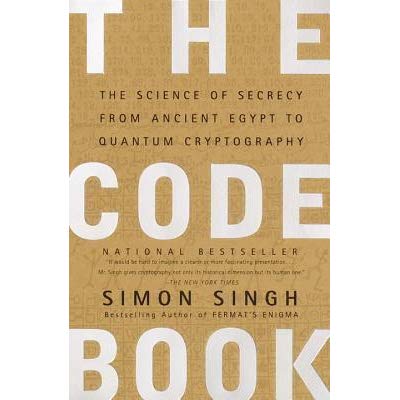For this class you’ll be using Canvas, a book, and my website TonySako.com. You will also be using several different web sites and utility programs. However there are too many to list here, so instead you will be provided links in each class section.
Canvas
Canvas will provide the main framework for the class. It has links to the major class resources, homework assignments, quizzes, and tests; and informs you of the optimal order for completing the class items. It also provides a calendar or schedule that shows you when specific items are due.
The Book
Hopefully you have already purchased the book for this class, but if not here is the book’s information:

Required Book: Simon Singh, “The Code Book” ISBN 0-385-49532-3
You can purchase it from the CBC book store or online. If you purchase it online you can purchase a used copy, but do NOT get the young adult edition.
This book contains stories about the application of cryptology throughout history, and I’ve selected it because the stories are very entertaining. It’s not only very entertaining, but it helps you see how the various cryptographic methods, and the ways to crack those methods evolved. And while it does go into the math behind behind some of the cryptographic methods, it isn’t just about the mathematical algorithms. The book is much more about how the methods were applied.
There are instructions in each Canvas Module that will let you know which specific chapters to read for that module, so please make sure and check carefully so that you read the correct material.
Suggested Reading
If you’re like me … well, hopefully for your sake your not too much like me LOL, but if like me you find cryptology fascinating and are interested in some of the stories, history and details of cryptology I also recommend reading:
- The Codebreakers: The Comprehensive History of Secret Communication from Ancient Times to the Internet by David Kahn
- Crypto by Steven Levy
- Codes Ciphers & Other Cryptic & Clandestine Communication by Fred B. Wrixon
TonySako.Com
If you’re reading this, then you’re already on my website. But I also want to point out that there’s a lot of extra information on my website that will help you with this class. In particular, make sure that you read the Lecture Notes. Besides being super interesting (LOL), they contain tips and extra directions for completing the assignments. And let me warn you, it will be very difficult to complete some of the assignments without this extra help.
If you’re in my class you’ll have free access to this class on my website during the quarter you take the class. If you want access to the material for other classes, or access to this class after the quarter ends, you can purchase a subscription for a small fee.
How to use the class resources
The book isn’t like a typical “school” book, as it doesn’t contain exercises or learning objectives for each chapter. It just tells the story of cryptology in a much more entertaining manner. This has caused a little confusion for a few students in the past, as they weren’t sure if they should be “studying” the book or concentrating on the material I’ve prepared, and if they’re not studying directly out of the book how they should use it.
I have two answers for the question about what to study, the book, and my material. Let me start by saying that I really like the book, and have read it a few times over the past 20 years. I think Singh does a great job of explaining the history and making it interesting. But the book is a little light on the technical details that I also think are important if you’re working in cyber security and want more than just an interesting read. So I’ve put together additional material to gently explain the technical aspects. My material isn’t nearly as entertaining as Singh’s, but it has a different objective.
And like any subject, cryptology has several levels that you should understand if you’re working in cyber security. There’s the low level mechanistic stuff, like the math and code. Then there’s the application level, things like how do we apply the cryptographic methods to do things like protect network transmissions or create the PKI. And then there’s the human/semantic level, things like who should be able to control or use cryptography, who should be able to have secrets, and who should make these decisions. The book gives decent perspective on the human level, but again is a little light on the mechanistic and application levels.
So … one of my answers or suggestions is to read the entire book to get the “big picture”, but use the other material to get the details on how the cryptographic methods actually function and how to apply them.
My other answer is, if you’re just worried about the tests and homework, you’ll probably want to spend more time on the material I provide. This is because you’ll have to know how to actually apply things in many of the questions and exercises.
